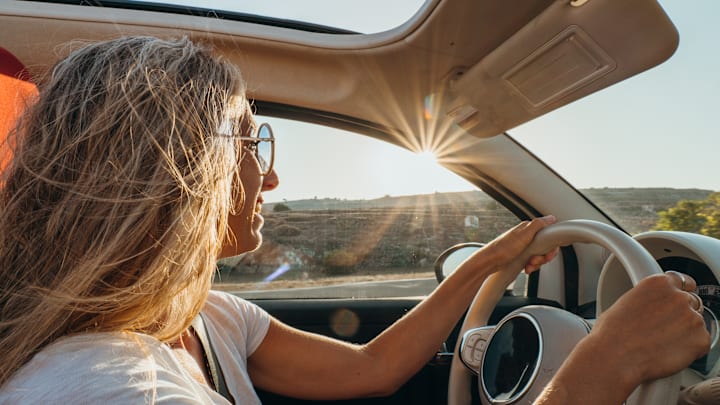People vigilant about shielding their skin from harmful UV rays usually reach for sunscreen when heading outdoors. But fewer take precautions while driving on the assumption that car windows block the sun’s rays from causing skin damage.
According to experts, the reality is more complicated than that. In many ways, being inside a car isn’t a whole lot different from being outdoors on a sunny day. Here’s why.
Car Windows and UV Rays
In a 2015 study published in JAMA Ophthalmology, 29 vehicles from a variety of manufacturers including Toyota, Honda, Mercedes, BMW, and Ford were tested to assess their filtering of ultraviolet-A (UV-A) light, which is believed to be a major contributing factor in the development of skin cancer and cataracts. Visiting several dealerships in Los Angeles, the paper’s author used a handheld UV-A light meter to gauge how much UV-A light was being passed through automotive glass. On average, a car’s front windshield blocked 96 percent of UV-A rays, making them an effective barrier against skin damage.
The side windows were another story. The average protection against UV-A was just 71 percent. Only four of the 29 cars tested had greater than 90 percent blockage on the side; some were as low as 50 percent. The price point of the car didn’t seem to make any difference.
You May Also Like:
- Why Does Driving With a Car's Rear Windows Down Hurt Your Ears?
- Does the UV Protection in Sunglasses Really Expire?
- 9 Terms You See On Sunscreen Bottles, Defined
- Can a Dead Body Still Get a Suntan?
The findings correlate with previous research into an increased likelihood of finding skin cancer or cataracts on the left side of the body, which would get the most sun exposure when driving a domestic vehicle driven on the right-hand side of the road.
The discrepancy in protection is the result of how cars are manufactured. Front windshields are typically two panes with a clear plastic layer in between that will keep the glass from shattering in the event of a collision. Side windows are more often made of tempered glass. The additional laminate layer of the front glass blocks the UV-A rays, not the glass itself. (UV-B rays, which are also implicated in skin cancer, are more easily blocked by glass of any type.)
Having a sunroof compounds the issue, as it permits more sunlight—and more UV-A—into the car. So while a driver is protected from the sun in the front, there's plenty of opportunity for skin exposure via the remaining windows.
Sunscreen and Driving
Clearly, car windows permit UV-A rays to penetrate into the cabin. But is it enough to warrant concern?
There is no consensus on a “safe” level of UV exposure, as that can depend on one’s complexion, the strength of the UV rays, and one’s susceptibility to skin issues. Someone may opt to apply sunscreen before walking their dog for 10 minutes; others won’t. But in general terms, if you’d apply sunscreen outdoors, you should be applying it on the portion of your body getting sun inside your vehicle.
Commenting on that 2015 study, University of Washington dermatology professor Paul Nghiem told Reuters that drivers and passengers should take the appropriate precautions when they plan on driving for a moderate amount of time. “Wearing long sleeve clothing, or sunscreen that is ‘broad spectrum,’ would be extremely effective and seems indicated on long drives on sunny days,” Nghiem said.
The Skin Cancer Foundation echoes this advice, adding that babies secured in the back passenger seats should also be protected. (Babies can begin wearing sunscreen at six months.)
Drivers can also opt for window tinting, which can make side window glass up to 99 percent effective in filtering UV light. Use caution, however, when shopping for tints, as some types might only be effective for privacy. You’ll also want to observe any local laws relating to the levels of tint that are permissible.
Sunscreen vs. Sunblock: What's the Difference? |
|---|
Car windows don’t do a great job of blocking UV rays, but sunscreen does. So why do people sometimes call it sunblock? While the terms seem interchangeable, they actually refer to different mechanisms of action. Sunscreen ingredients work to absorb UV rays, while sunblock blocks them entirely by reflecting light away from your skin. For that reason, sunblock can feel thicker when applied than sunscreen. |
While anyone driving should be cognizant of UV rays, protection is especially important for anyone who makes a living on the road. Cumulative sun damage can promote skin cancer as well as premature aging. One delivery driver profiled in the New England Journal of Medicine in 2012 offered an example: After nearly three decades of work, the right side of his face was largely wrinkle-free. The left, exposed to the sun, was considerably more lined, a contrast that made his photo go viral.
Cars aren’t the only possible UV hazard in transportation. Airplane, train, and bus windows can pose similar risks, as can working near a building window. If you plan to be sitting where you’ll get sun exposure for a period of time, you should probably cover up or use sunscreen in the same way you would if you were going to be outdoors. If a window is letting in light, then chances are it’s letting in UV rays.
